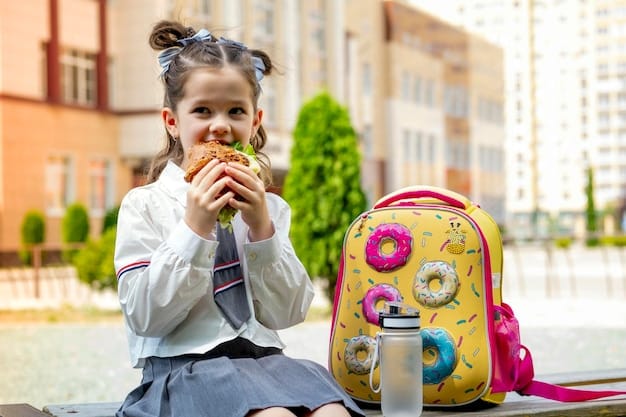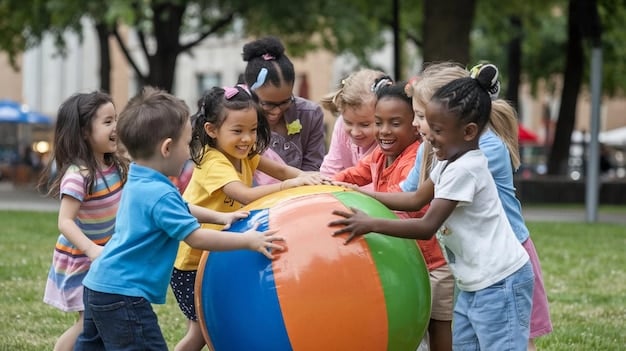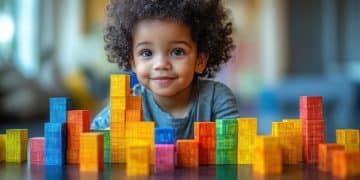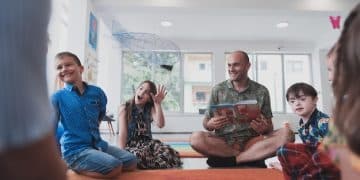Kindergarten Readiness: A Comprehensive Parent Checklist

Navigating the transition to kindergarten requires a thorough understanding of developmental milestones across social, emotional, cognitive, and physical domains, ensuring children are prepared for academic and social success in their new learning environment.
The journey to kindergarten is a significant milestone for both children and parents, marking the beginning of formal schooling and a new chapter of growth and discovery. Determining whether your child is genuinely ready for this exciting step involves more than just age; it encompasses a broad spectrum of developmental areas. This comprehensive checklist, Is Your Child Ready for Kindergarten? A Comprehensive Checklist for Parents, is designed to guide you through the essential social, emotional, cognitive, and physical readiness indicators, helping you assess your child’s preparedness and foster a smooth transition into their new educational adventure.
understanding kindergarten readiness: beyond academics
Kindergarten readiness is frequently misunderstood as solely focusing on a child’s ability to count to ten or recite the alphabet. While these academic foundations are beneficial, the true measure of readiness extends far beyond rote memorization. It involves a holistic view of a child’s development, recognizing that social and emotional skills are just as crucial as cognitive abilities for navigating the school environment. A child who can manage their emotions, interact positively with peers, and follow simple instructions is often better equipped for academic success than one who merely knows their letters but struggles with self-regulation.
Preparing a child for kindergarten means nurturing their independence, curiosity, and resilience. This preparation is a collaborative effort between parents and educators, focusing on creating an environment where children feel secure enough to explore, question, and learn from their experiences. It’s about building a strong foundation that supports not only their initial entry into school but also their long-term educational journey and overall well-being. Understanding this broader definition allows parents to approach kindergarten readiness with a more balanced and effective strategy.
holistic development: the interwoven threads
The different aspects of a child’s development are not isolated; they are deeply interwoven, each influencing and supporting the others. For instance, a child’s ability to communicate effectively (language skills) directly impacts their social interactions (social-emotional skills), which in turn can affect their problem-solving approaches (cognitive skills). This interconnectedness means that fostering growth in one area often has positive ripple effects across others.
- Encourage open communication: create safe spaces for children to express thoughts and feelings.
- Provide diverse learning experiences: expose children to various activities that stimulate different developmental areas.
- Support emotional regulation: teach children healthy ways to identify and manage emotions.
- Foster independence: allow children to take on age-appropriate responsibilities.
Parents play a pivotal role in observing and supporting these interconnected developments. By understanding how each domain contributes to the overall readiness, parents can tailor their efforts to meet their child’s unique needs. This approach minimizes stress for both child and family, ensuring a more confident and joyful start to formal education. The goal is to cultivate a well-rounded individual ready to embrace new challenges with enthusiasm.
social and emotional readiness: building foundational relationships
The social and emotional landscape of kindergarten can be vastly different from a child’s home environment. In a classroom, children are expected to share, take turns, understand others’ perspectives, and manage their feelings in a group setting. These skills are fundamental for forming friendships, engaging in cooperative play, and participating constructively in classroom activities. A child’s ability to cope with separation from parents, adapt to new routines, and navigate social dynamics with peers and teachers is a strong indicator of their emotional maturity.
Developing social-emotional readiness often starts in preschool or at home through playdates and group activities. These experiences provide valuable opportunities for children to practice negotiation, conflict resolution, and empathy. Parents can actively model positive social behaviors and encourage their children to express their feelings appropriately, teaching them strategies for managing frustration or excitement. These early lessons in self-regulation and social interaction lay the groundwork for successful peer relationships and a positive attitude towards learning.

key social competencies for school
Entering kindergarten successfully relies heavily on a child’s ability to engage with others and understand social cues. These competencies prevent isolation and ensure the child feels part of the new community. From sharing toys to understanding group rules, each skill contributes to a cohesive learning atmosphere.
- Ability to share toys and materials with peers without constant supervision.
- Capacity to take turns during games and group activities, respecting others.
- Understanding and following simple rules and instructions given by adults.
- Initiating and maintaining friendships through positive interactions.
Emotional regulation is another critical component. Children who can identify their feelings and express them constructively are better able to handle the challenges of a new environment. This often means being able to verbalize when they are upset, ask for help, or calm themselves down. These skills reduce behavioral disruptions and foster a more attentive and engaged learner. Parents can support this by validating their child’s feelings and coaching them through difficult emotions.
Developing empathy also plays a crucial role in social interactions. When children can understand and respond to the feelings of others, they are more likely to engage in compassionate behavior and build stronger connections. This leads to a more inclusive and supportive classroom environment, benefiting all children. Encouraging conversations about feelings and consequences of actions can significantly boost a child’s empathetic development.
cognitive readiness: equipping young minds for learning
Cognitive readiness for kindergarten involves a child’s developing abilities in thinking, reasoning, and problem-solving. This isn’t about formal academics as much as it is about foundational learning skills. For instance, being able to follow a two-step instruction, recognize patterns, or understand basic concepts like “same” and “different” are crucial. These skills are the building blocks upon which more complex academic learning will be constructed.
Language development is a core component of cognitive readiness. A child’s vocabulary, ability to express themselves clearly, and understanding of spoken language directly impact their capacity to learn new concepts and participate in classroom discussions. Exposure to books, storytelling, and conversations from an early age significantly enhances these linguistic capabilities. Children who are engaged verbally tend to develop stronger cognitive tools.
early literacy and numeracy concepts
While formal reading and math are not expected, familiarity with basic concepts provides a significant advantage. These early exposures make the subsequent learning process smoother and more engaging for children. It also helps teachers build upon existing knowledge rather than starting from scratch.
- Recognizing some letters of the alphabet and understanding that print carries meaning.
- Counting objects up to 10 or 20 and understanding one-to-one correspondence.
- Identifying basic shapes and colors, and understanding simple spatial relationships.
- Enjoying listening to stories and showing interest in books and reading.
Problem-solving skills are also integral to cognitive readiness. This includes the ability to identify a problem, try different solutions, and learn from mistakes. Such resilience in the face of challenges prepares children for academic tasks that require persistence and critical thinking. Encouraging children to think through puzzles or everyday dilemmas helps nurture these skills effectively.
Memory and attention span are other key cognitive areas. A child’s ability to remember a series of instructions or focus on a task for a short period is essential for classroom learning. Engaging children in memory games, storytelling, and structured playtime can help to extend their attention spans and improve recall. These activities not only make learning fun but also solidify crucial cognitive foundations.
physical readiness: movement, coordination, and self-care
Physical readiness often goes underestimated but is vital for a child’s success in kindergarten. It encompasses both fine motor and gross motor skills, as well as basic self-care abilities. Gross motor skills, like running, jumping, and balancing, are important for playground activities and participation in physical education. Fine motor skills, such as holding a pencil correctly, cutting with scissors, and manipulating small objects, are essential for handwriting, drawing, and other classroom tasks.
Beyond motor skills, self-care routines are crucial. A child’s ability to use the bathroom independently, wash their hands, dress themselves, and manage their belongings demonstrates a level of autonomy that supports classroom efficiency and reduces reliance on teacher assistance. These practical life skills foster independence and confidence, allowing children to focus more on learning and less on basic needs.

developing motor skills and independence
From the playground to the classroom, physical capabilities impact every aspect of a child’s day. Ensuring adequate development in these areas supports engagement and reduces frustrations related to physical tasks. This preparation makes the school environment less daunting and more navigable.
- Coordinated movement for running, jumping, and playing on playground equipment.
- Proper pencil grasp and control for drawing, writing, and tracing.
- Ability to use scissors to cut along lines and shapes accurately.
- Managing personal hygiene, including using the toilet and washing hands independently.
Furthermore, adequate sleep and good nutrition are foundational to physical readiness, impacting a child’s energy levels, concentration, and overall health. A well-rested and well-fed child is better able to engage in learning, regulate their emotions, and participate actively in school life. Establishing consistent routines around these aspects can significantly contribute to their readiness.
Hand-eye coordination is another important physical skill that helps children with tasks like catching a ball, completing puzzles, or even simply turning pages in a book. Activities that involve throwing, catching, stacking blocks, or drawing can help develop this coordination. These seemingly simple actions are complex developmental achievements that facilitate a smoother integration into kindergarten activities.
language and communication skills: the cornerstone of learning
Effective language and communication skills are the bedrock of kindergarten success. A child’s ability to articulate their thoughts, ask questions, follow directions, and understand stories directly impacts their capacity to learn from teachers and interact with peers. This includes both receptive language (understanding what is said) and expressive language (communicating one’s own thoughts and needs).
Encouraging a rich language environment at home is paramount. Reading aloud together, engaging in conversations about daily events, asking open-ended questions, and narrating activities can significantly boost a child’s vocabulary and comprehension. These interactions not only enhance linguistic abilities but also build a strong connection between parent and child, fostering a love for words and stories.
developing expressive and receptive language
The ability to both speak and comprehend is fundamental for all classroom activities and social interactions. Strengthening these areas ensures children can fully participate and feel understood, which boosts their confidence and engagement with learning materials. Early intervention and consistent practice are key.
- Speaking in complete sentences to express thoughts and ideas clearly.
- Understanding and following multi-step directions without constant reminders.
- Answering “wh” questions (who, what, where, when, why) appropriately.
- Listening attentively to stories and being able to retell parts of them.
Phonological awareness, the ability to hear and manipulate the sounds in words, is a critical pre-reading skill. Simple activities like rhyming games, identifying the beginning sounds of words, and clapping out syllables can lay a strong foundation for reading success. These playful explorations of language help children decode words more easily when they begin formal instruction.
Furthermore, teaching children how to ask for help or express confusion is a vital communication skill. This empowers them to advocate for their needs and ensures they receive the support necessary to succeed, rather than struggling silently. Role-playing different scenarios can help children practice these crucial interactions, building their confidence in new social settings.
academic foundations: fostering early learning curiosity
While kindergarten readiness is not solely about academics, building strong academic foundations can significantly ease a child’s transition and set them up for early success. This involves nurturing a natural curiosity for learning and introducing basic concepts in a fun, pressure-free environment. Exposure to numbers, letters, and foundational science concepts through play and exploration can be highly beneficial.
Engaging children with educational games, puzzles, and interactive books helps them develop a positive association with learning. It’s not about drilling facts but about sparking interest and showing them that discovering new things can be exciting. This early positive exposure can cultivate a lifelong love of learning and exploration, which is an invaluable asset for school.
pre-reading and pre-math skills
A gentle introduction to pre-reading and pre-math skills ensures children arrive at school with a sense of familiarity and confidence. This early exposure helps them recognize patterns and structures, making formal instruction less intimidating and more engaging. These skills are often best developed through playful, hands-on activities rather than strict lessons.
- Recognizing and naming uppercase and lowercase letters of the alphabet.
- Understanding number concepts up to 10 or 20, including counting and quantity.
- Identifying and extending simple patterns (e.g., ABAB, AABB).
- Showing interest in storytelling, writing, and drawing as forms of communication.
Developing fine motor skills in preparation for writing is also a crucial academic foundation. Activities like drawing, coloring, tracing, and playing with playdough strengthen the small muscles in a child’s hands and fingers. These skills are directly transferred to holding a pencil and forming letters more comfortably when formal writing instruction begins, reducing potential frustration.
Exposure to a variety of print materials, from storybooks to road signs and labels, helps children understand that print carries meaning and is present everywhere. Pointing out words and letters in everyday contexts can significantly enhance their literacy awareness. This broad exposure integrates learning into daily life, making it a natural part of their world.
preparing for the transition: practical tips for parents
The transition to kindergarten is a significant adjustment for both children and parents. Proactive preparation can ease anxieties and build excitement for the new adventure. This involves not only preparing the child developmentally but also making practical arrangements and mentally preparing the family unit for this change. Creating a positive narrative around school is essential.
Visits to the school, meeting the teacher, and familiarizing the child with the classroom environment can significantly reduce apprehension. Reading books about starting kindergarten can also help children understand what to expect and process their feelings. These small steps can make a big difference in building a child’s confidence and sense of security.
creating a supportive home environment
A supportive home environment facilitates a smoother transition to kindergarten by reinforcing routines and fostering independence. This means aligning home practices with school expectations where possible, but also ensuring the child feels loved and secure. Consistency and reassurance are key during this period of change.
- Establish a consistent daily routine, including regular sleep and meal times.
- Practice separation by arranging playdates or short periods away from primary caregivers.
- Talk positively about school, focusing on the exciting new experiences and friends.
- Encourage independence in daily tasks like dressing, eating, and tidying up.
Open communication with the school is another critical aspect of preparation. Attending orientation sessions, asking questions, and understanding the school’s philosophy and routines can help parents feel more informed and connected. This partnership between home and school is vital for addressing any concerns and supporting the child’s learning journey effectively.
Finally, remember to celebrate this milestone! The start of kindergarten is a momentous occasion. Acknowledging its importance, perhaps with a special ritual or small celebration, can help children feel valued and excited about this new chapter. This positive reinforcement reinforces that school is a place of growth, discovery, and joy.
| Key Area | Brief Description |
|---|---|
| 💖 Social Skills | Ability to share, take turns, and interact positively with peers and adults. |
| 🧠 Cognitive Growth | Following directions, problem-solving, and basic understanding of concepts. |
| 🤸 Physical Development | Fine motor skills (holding pencil) and self-care (dressing, hygiene). |
| 🗣️ Communication | Expressing needs, understanding language, and actively engaging in conversations. |
frequently asked questions about kindergarten readiness
The most important factor for kindergarten readiness is a child’s social-emotional development. While academic exposure is beneficial, the ability to regulate emotions, interact positively with peers, follow rules, and adapt to new routines forms the bedrock for learning. Children who are emotionally secure and socially capable are better equipped to engage with classroom activities and benefit from academic instruction.
Most states in the US require children to be five years old by a specific date, typically in late summer or early fall, to enroll in kindergarten. However, the optimal age can vary by individual child. Some parents choose to “redshirt” their child, delaying entry by a year if they feel specific developmental areas, such as social maturity or attention span, need more time to develop. It’s best to consult local school district guidelines and assess your child’s overall readiness.
You can foster pre-reading skills by reading aloud frequently, engaging in rhyming games, identifying letters and their sounds, and allowing your child to ‘read’ picture books independently. Point out words and letters in everyday environments like street signs and cereal boxes. Encourage storytelling and asking questions about stories, fostering phonological awareness and a love for literature.
It’s common for children to develop at their own pace and not meet every milestone simultaneously. If you have concerns, speak with your child’s pediatrician, preschool teacher, or a developmental specialist. They can offer guidance, suggest targeted activities, or recommend early intervention services if appropriate. Focusing on specific areas for growth with patient support is often more effective than pushing for formal academics.
Independent self-care is very important for kindergarten success. The ability to use the restroom independently, wash hands, dress oneself, and manage personal belongings like lunchboxes and coats reduces reliance on teacher assistance, allowing educators to focus on instruction. These skills also boost a child’s confidence and foster a sense of autonomy in the classroom setting.
conclusion: embarking on the kindergarten journey with confidence
The transition to kindergarten is a momentous occasion, a blend of excitement and perhaps a touch of apprehension for both children and parents. By focusing on a holistic view of readiness—encompassing social-emotional, cognitive, language, and physical development—parents can equip their children with the crucial skills needed not just to survive, but to truly thrive in their new learning environment. This comprehensive checklist serves as a valuable tool, guiding you through the various developmental milestones and offering insights into how best to support your child. Remember, kindergarten readiness is not about perfection, but about fostering a strong foundation of confidence, curiosity, and adaptability that will serve your child well throughout their educational journey.





